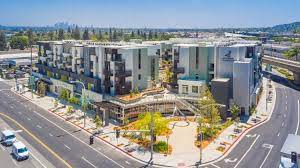Revisiting Takoma Junction and the Takoma Co-op development issue | A chance to start over
The Washington Post reports that the Montgomery County Planning Board has rejected the development proposal for the Takoma Junction parking lot site in Takoma Park, Maryland ("Montgomery planners reject Takoma Park development").
I wrote about this project in 2018 ("The lost opportunity of the Takoma Food Co-op as a transformational driver for the Takoma Junction district").
I lamented that the project is extraordinarily contentious because it involves the Takoma Co-op, the parking lot next door which is owned by the city, the general anti-development sentiment of "Tako-manians" (this was what someone I met calls residents of Takoma Park), and the ability of the member-based Co-op to mobilize its members to oppose what it wants to be opposed.
Currently the site is a parking lot, which has been used by many of the Co-op's shoppers, and also as a site for community events.
Takoma anti-development attitudes that are behind the times. Attempts to develop the site have meandered for 20+ years, comparable to the Takoma Metrorail site ("The Takoma Metro Development Proposal and its illustration of gaps in planning and participation processes," 2014) and the two sites share similar issues:
-- historical anti-development sentiment which resulted in key victories, shaping for 50 years the ethos and attitudes of involved Takoma residents
Note that these successes were key--fighting off proposals for urban freeways, and later, development proposals that were inappropriate for the Takoma Metrorail site, but those successes have led many people to reflexively oppose everything, rather than to be judicious in what they support as well as what they don't support.
- an unwillingness to acknowledge that anchor sites in commercial districts have different development conditions than residential areas typified by one and two story houses
Non profit food cooperatives can be part of mixed use developments. The 2018 piece lists a number of mixed use projects around the country with food co-operatives on the ground floor--Seattle, Minneapolis, Rochester, Minnesota, Brattleboro, Vermont, and Great Barrington, Massachusetts--with mostly housing above.
Of course, the DC area, including Suburban Maryland and Northern Virginia, has plenty of examples of mixed use grocery projects involving for profit supermarkets, including Giant, Safeway, Harris-Teeter, the small independent Streets (three stores in DC and one in Arlington), Walmart, Aldi, and the smaller Yes Market Natural Grocery--in another project developed by the Neighborhood Development Company nearby on Georgia Avenue in the Petworth neighborhood of DC.
Takoma Junction is underpowered. As a commercial district, Takoma Junction isn't particular successful, other than the Food Co-op, because it doesn't have a lot of nearby population.Takoma Park is mostly single family residential with comparatively big lots, so other than the Co-op, a gas station and auto repair place, there isn't a lot going on there, and quality retailers don't tend to last.
Likely most of the Co-op's customers drive.
Ideally the parking lot site would be developed in conjunction with the Takoma Co-op, by incorporating its current site/building (and even the abutting Takoma Fire Station), allowing for a larger mixed use project, using as models the projects I mentioned in the 2018 piece.
Instead because of the Co-op's intransigence, the parking lot project was designed to be separate from the Co-op, and because of residents reflexive opposition to buildings taller than two stories, not particularly transformational.
The Takoma Junction MC project adds space, albeit more modern, in an area where space isn't the problem, the problem is the attractiveness of the retail offerings and whether or not they are attractive enough to draw customers from a larger area.
Not including housing is a significant opportunity cost, because of the clear demand for housing in the Washington Metropolitan Area, the almost zero availability of build out opportunities in the core of Takoma Park, and the fact that the site is within reasonable walking distance of the Takoma Metrorail Station.
The best possible project would create an awesome co-op grocery, and a bit more retail space, while adding housing--2-3 floors of apartments, to add housing and broaden the range of housing types available in Takoma Park. Ideally 3, even 4 stories of apartments, would be best, although it would be taller than other buildings in the Junction.
Examples of nearby projects as models would be the Takoma Central apartments on Carroll Avenue in DC, which peak at about four stories; the Gables Apartments on Blair Road, or the smaller Willow + Maple "garden apartments."
Puget Consumers Cooperative, Seattle. Last week the PCC Co-op in Seattle just opened its newest store ("‘Our city’s not dead yet’: PCC opening highlights promise of, and challenges to, downtown Seattle’s recovery," Seattle Times, press release) and while I haven't visited the store, I have visited others.
It's part of a Downtown skyscraper, 58 stories, with other retail, offices, and apartments.
Now PCC has five stores in Seattle that are part of mixed use developments. There is also the Central Co-op in Capitol Hill, which is topped by apartments too.
The other co-operative + housing projects mentioned in the previous entry are all much smaller, and more typical of a site like the one in Takoma Park.
PCC is a top notch operation that would be a great model for the Takoma Food Co-op, as a way to reposition and expand.
The rejection by the Planning Board provides an opportunity to start over. The rejection of the development proposal by the Montgomery County Planning Board gives the stakeholders in Takoma Junction the chance to start over and create an awesome project.
The project as proposed was a waste of an opportunity to do something great. Once a site is developed, it becomes much harder to redevelop, so better that the project not go forward at this particular time.
If Takoma Park is capable of breaking out of its narrow ways, the City, the Co-op (as a member of the National Cooperative Grocer Association, the Takoma Co-op should be familiar with best practice and mixed use cooperatives around the country), Neighborhood Development Company, and interested residents could start over, work together jointly, and develop a project they could be proud of, one that would improve: (1) the Co-op, (2) Takoma Junction, and (3) Takoma Park, while (4) adding a significant number of housing units.
Another best in class example: Co-Opportunity Co-op in Culver City, California. A year after I wrote the 2018 piece, in 2019, riding the Expo Line in LA, I noticed this co-op, and got off the train--a short walk from the Culver City stop--to check it out.
While the exterior's architectural design doesn't appeal to me, the Co-op is part of the Access Culver City mixed use project, which includes the Co-op at 19,000 s.f., another 12,000 s.f. of retail, and 115 apartments. The building is fronted by an outdoor patio, which extends"eat in" space for the Co-op.
The grocery is super attractive, with prepared foods and an eat-in area.The Culver City site is bigger than the Takoma Junction site, unless they could include the adjoining fire station.
By going to four or even five stories, there's an opportunity to add 80+ housing units, as well as build an amazing new co-operative grocery store, and have underground parking.
A Takoma Junction project comparable to the Access Culver City project would be a win-win-win becoming a more significant anchor for Takoma Junction.
Takoma Co-op has to ask itself some hard questions. First, do they want to be part of a great project, resulting in a better store? Second, are they willing to work with others in a joint venture? Third, are they willing to create a better store, by measuring their operation against best practice cooperatives operating elsewhere, and change to be better and more competitive?
WRT the third question, the Co-op has to consider whether or not it's willing to expand its product offerings to be able to appeal to a wider audience. Beyond merely increasing the size of current, underpowered departments like produce, dairy, beer and wine. Adding prepared foods and a cafe and selling meat should be on the table too.
Kelly Kawarchi is the head butcher at Blackbelly Market. Photo: Boulder Weekly.Takoma Junction as a food district. If the Takoma Co-op is willing to do some things and not others, but still participate in a bigger project as a joint venture, the city should consider trying to make the area a small "food district," recruiting other businesses to fill the holes in the current product offering.
This would attract patrons from beyond the immediate area.
There's already a great bread bakery across the street, Spring Mill Bread Company. But the Co-op could add an in-house bakery operation too, with a broader range of goods.
If the co-op isn't willing to offer meat products, a high quality artisan independent butcher could be recruited. In the DC area, Red Apron, the butcher operated by the Neighborhood Restaurant Group is one example. But there are plenty of examples of such butchers across the country
Kaldi's Coffee House in nearby Silver Spring is an amazing experience and a good model for a great coffee shop.
I don't know why the nearby, but not at Takoma Junction, Capital City Confectionary closed. It was up the street on Carroll Avenue (albeit in a space where the businesses come and go). If it were part of a bigger food district anchored by an amazing food co-op, it would have had a better chance of surviving.
Labels: building regulation, civic engagement, commercial district revitalization planning, real estate development, supermarkets-groceries, urban planning, urban revitalization, zoning



























